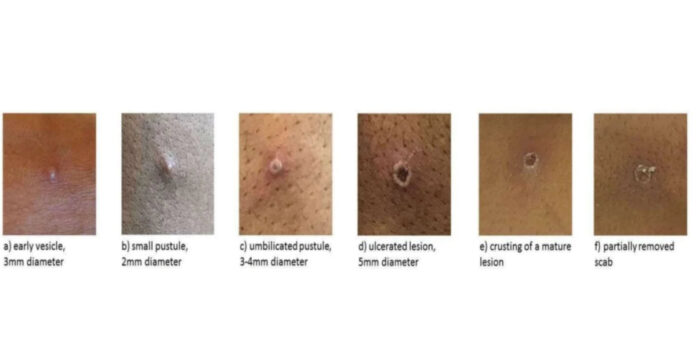On the heels of COVID-19, there are new concerns about monkeypox, a virus that gives you flu-like symptoms (fever, sore muscles, and fatigue) followed within three days by a rash. The rash can appear anywhere (but is often on the face, arm and hands) and turns into pustules or skin lesions that have an indent in the middle. These eventually scab over and heal, but they can leave scarring. Active in Africa for years, monkeypox has recently spread around the globe, with many early cases being associated with gay or bisexual men, especially those who had traveled to gay pride events.
While there are approximately 1200 cases in 31 countries, there are just 45 in the U.S. According to this article on cnn.com, the virus does not spread through the air.
Monkeypox spreads through direct contact with body fluids or sores on the body of someone who has been infected, or through direct contact with materials that have touched body fluids or sores, such as bed sheets or clothing, according to the CDC.
The spread of monkeypox through small virus particles that linger in the air “has not been reported,” the CDC said in guidance posted Thursday. It may spread through “saliva or respiratory secretions” during face-to-face contact, but these secretions “drop out of the air quickly,” and this method of transmission seems uncommon.
The CDC has said that the risk to the general public remains low, but health care providers should be alert for patients who have rash or illness consistent with monkeypox.
Between 3 and 6 percent of people with monkeypox die from the disease, although the rate may be higher among children. There are two known strains, and the one in the U.S. appears to be the weaker, less dangerous strain.
Are You at Risk?
Given that there is not yet any community spread in the U.S. and only 45 known cases, the chance of contacting it is extremely low. 45 known cases out of 320 million people is not much to worry about, unless is starts spreading rapidly. If you monitor the news and next week there are 90 or 190 cases, then that’s a bad portent for the future, but still not an immediate concern. If the caseload spreads, use the rate of increases as a barometer for your preps.
While monkeypox can infect anyone regardless of gender or sexual preferences, sex between men has been the primary route of transmission in this outbreak. If you or your sex partner is a man that has sex with other men, this might be a good time to practice monogamy and cut back on social activities where you risk exposure to a potential carrier. For those not in this group, the chance of infection is lower, at least until monkeypox breaks out into the broader population.
If you have or think you have been in close contact with an infected person, isolate yourself to avoid further spread and contact your state health department to arrange testing and possible vaccination. The FDA approved a vaccine for monkeypox in 2019. The vaccine can be given prophylactically or after exposure to the virus.
Relative Risk
We are in the middle of an inflationary crisis in which gasoline and food prices are putting strain on almost everyone’s budget. We will likely experience a recession and severe economic pain over the balance of this year. There is a war in Europe and threats of war in hotspots around the globe. The use of nuclear weapons is being discussed openly for the first time in decades. COVID-19 is still infecting more than 100,000 people daily in the U.S., resulting in a few hundred deaths per day. Compared to these much larger issues, the infinitesimal chance of contacting monkey pox should be at the very bottom of your worry list. I rank it right there with getting hit by a comet; yes, it’s not inconceivable, but we’ll have an advance warning before it becomes an active threat.
There are three likely paths this illness can take:
- Monkeypox can go away for months or years until another outbreak reaches our shores.
- It can remain a low-level threat with a few new cases per week, mostly in gay or bisexual men and those close to them.
- It can spread and get worse.
Obviously, the first two are nothing to worry about and monkeypox can languish on the list of dangerous viruses that pop up from time to time but are not a broad threat. It’s the third one we have to worry about, but if you think back to the spring of 2020, this is not spreading at the rate COVID-19 did.
Monitor the News
My advice is to monitor the news about monkeypox. Look at its rate of spread. Look for surges in the case count that might represent a change in how it spreads. Of course, you can count on the Pickled Prepper to keep you up to date and let you know if it should move up on your list of things that should be of concern.
You May Already Be Protected
Because monkeypox and smallpox are both in the orthopoxvirus family, anyone vaccinated for smallpox may have some immunity against monkeypox. Childhood smallpox vaccinations ended in 1972, but younger people may have received the smallpox vaccine in the military or if they traveled abroad prior to 1982. Smallpox vaccination was required for all service members until 1990. After that, it was given to those heading to the Middle East or other areas where smallpox attacks were considered a possibility.
The more recent your vaccination is, the stronger your protection. Whether the vaccine remains effective 50 or more years later is a question, we’d prefer not to test.








